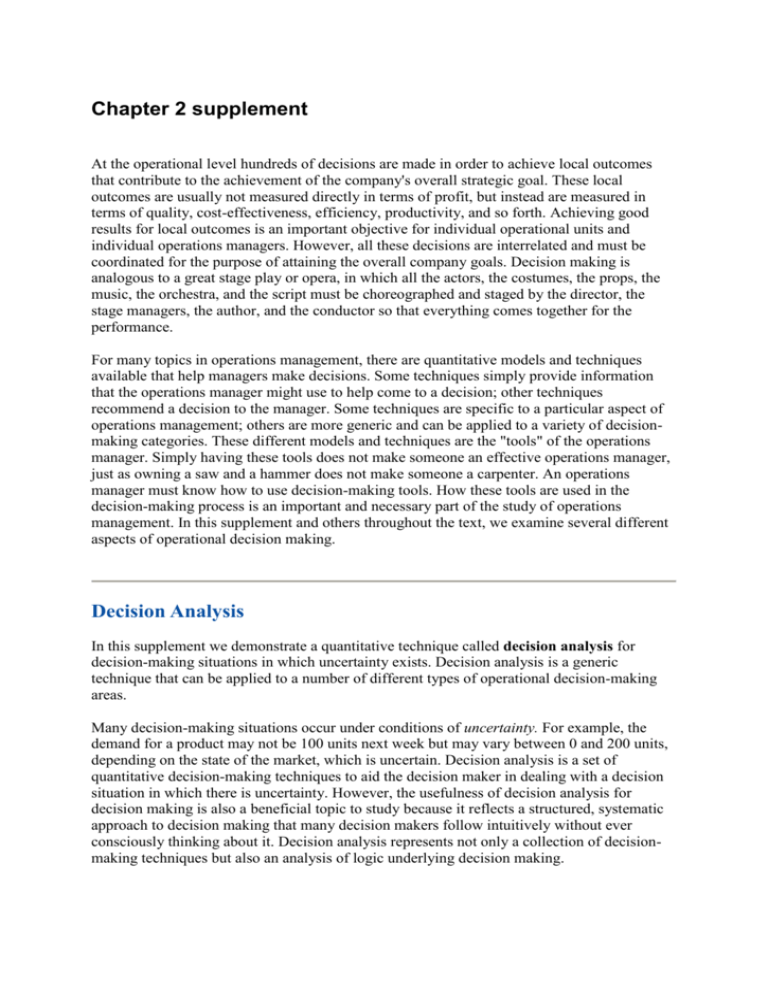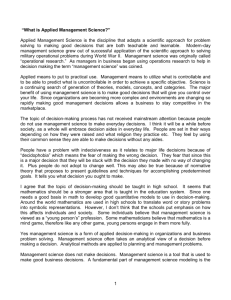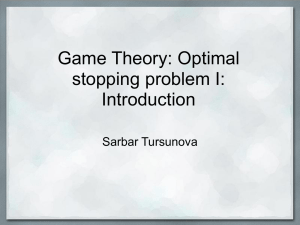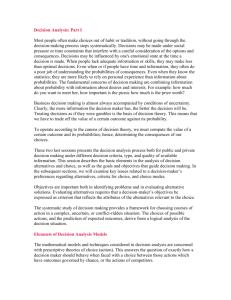Chapter 2 supplement
advertisement

Chapter 2 supplement At the operational level hundreds of decisions are made in order to achieve local outcomes that contribute to the achievement of the company's overall strategic goal. These local outcomes are usually not measured directly in terms of profit, but instead are measured in terms of quality, cost-effectiveness, efficiency, productivity, and so forth. Achieving good results for local outcomes is an important objective for individual operational units and individual operations managers. However, all these decisions are interrelated and must be coordinated for the purpose of attaining the overall company goals. Decision making is analogous to a great stage play or opera, in which all the actors, the costumes, the props, the music, the orchestra, and the script must be choreographed and staged by the director, the stage managers, the author, and the conductor so that everything comes together for the performance. For many topics in operations management, there are quantitative models and techniques available that help managers make decisions. Some techniques simply provide information that the operations manager might use to help come to a decision; other techniques recommend a decision to the manager. Some techniques are specific to a particular aspect of operations management; others are more generic and can be applied to a variety of decisionmaking categories. These different models and techniques are the "tools" of the operations manager. Simply having these tools does not make someone an effective operations manager, just as owning a saw and a hammer does not make someone a carpenter. An operations manager must know how to use decision-making tools. How these tools are used in the decision-making process is an important and necessary part of the study of operations management. In this supplement and others throughout the text, we examine several different aspects of operational decision making. Decision Analysis In this supplement we demonstrate a quantitative technique called decision analysis for decision-making situations in which uncertainty exists. Decision analysis is a generic technique that can be applied to a number of different types of operational decision-making areas. Many decision-making situations occur under conditions of uncertainty. For example, the demand for a product may not be 100 units next week but may vary between 0 and 200 units, depending on the state of the market, which is uncertain. Decision analysis is a set of quantitative decision-making techniques to aid the decision maker in dealing with a decision situation in which there is uncertainty. However, the usefulness of decision analysis for decision making is also a beneficial topic to study because it reflects a structured, systematic approach to decision making that many decision makers follow intuitively without ever consciously thinking about it. Decision analysis represents not only a collection of decisionmaking techniques but also an analysis of logic underlying decision making. Decision-Making Without Probabilities A decision-making situation includes several components--the decisions themselves and the events that may occur in the future, known as states of nature. Future states of nature may be high demand or low demand for a product or good economic conditions or bad economic conditions. At the time a decision is made, the decision maker is uncertain which state of nature will occur in the future and has no control over these states of nature. When probabilities can be assigned to the occurrence of states of nature in the future, the situation is referred to as decision making under risk. When probabilities cannot be assigned to the occurrence of future events, the situation is called decision making under uncertainty. We discuss this latter case next. To facilitate the analysis of decision situations, they are organized into payoff tables. A payoff table is a means of organizing and illustrating the payoffs from the different decisions, given the various states of nature, and has the general form shown in Table S2.1. Each decision, 1 or 2, in Table S2.1 will result in an outcome, or payoff, for each state of nature that will occur in the future. Payoffs are typically expressed in terms of profit, revenues, or cost (although they may be expressed in terms of a variety of quantities). For example, if decision 1 is to expand a production facility and state of nature a is good economic conditions, payoff 1a could be $100,000 in profit. Once the decision situation has been organized into a payoff table, several criteria are available to reflect how the decision maker arrives at a decision, including maximax, maximin, minimax regret, Hurwicz, and equal likelihood. These criteria reflect different degrees of decision-maker conservatism or liberalism. On occasion they result in the same decision; however, they often yield different results. These decision-making criteria are demonstrated by the following example. EXAMPLE S2.1 Decision-Making Criteria Under Uncertainty The Southern Textile Company is contemplating the future of one of its plants located in South Carolina. Three alternative decisions are being considered: (1) Expand the plant and produce lightweight, durable materials for possible sales to the military, a market with little foreign competition; (2) maintain the status quo at the plant, continuing production of textile goods that are subject to heavy foreign competition; or (3) sell the plant now. If one of the first two alternatives is chosen, the plant will still be sold at the end of the year. The amount of profit that could be earned by selling the plant in a year depends on foreign market conditions, including the status of a trade embargo bill in Congress. The following payoff table describes this decision situation. Determine the best decision using each of the decision criteria. 1. 2. 3. 4. 5. Maximax Maximin Minimax regret Hurwicz Equal likelihood SOLUTION: 1. Maximax The decision is selected that will result in the maximum of the maximum payoffs. This is how this criterion derives its name--the maximum of the maxima. The maximax criterion is very optimistic. The decision maker assumes that the most favorable state of nature for each decision alternative will occur. Thus, for this example, the company would optimistically assume that good competitive conditions will prevail in the future, resulting in the following maximum payoffs and decisions: Decision: Maintain status quo 2. Maximin The maximin criterion is pessimistic. With the maximin criterion, the decision maker selects the decision that will reflect the maximum of the minimum payoffs. For each decision alternative, the decision maker assumes that the minimum payoff will occur; of these, the maximum is selected as follows: Decision: Expand 3. Minimax Regret The decision maker attempts to avoid regret by selecting the decision alternative that minimizes the maximum regret. A decision maker first selects the maximum payoff under each state of nature; then all other payoffs under the respective states of nature are subtracted from these amounts, as follows: These values represent the regret for each decision that would be experienced by the decision maker if a decision were made that resulted in less than the maximum payoff. The maximum regret for each decision must be determined, and the decision corresponding to the minimum of these regret values is selected as follows: Decision: Expand 4. Hurwicz A compromise between the maximax and maximin criteria. The decision maker is neither totally optimistic (as the maximax criterion assumes) nor totally pessimistic (as the maximin criterion assumes). With the Hurwicz criterion, the decision payoffs are weighted by a coefficient of optimism, a measure of the decision maker's optimism. The coefficient of optimism, defined as , is between 0 and 1 (i.e., 0 1.0). If 1.0, then the decision maker is completely optimistic, and if 0, the decision maker is completely pessimistic. (Given this definition, 1 is the coefficient of pessimism.) For each decision alternative, the maximum payoff is multiplied by and the minimum payoff is multiplied by 1 . For our investment example, if equals 0.3 (i.e., the company is slightly optimistic) and 1 0.7, the following decision will result: Decision: Expand 5. Equal Likelihood The equal likelihood (or LaPlace) criterion weights each state of nature equally, thus assuming that the states of nature are equally likely to occur. Since there are two states of nature in our example, we assign a weight of 0.50 to each one. Next, we multiply these weights by each payoff for each decision and select the alternative with the maximum of these weighted values. Decision: Expand The decision to expand the plant was designated most often by four of the five decision criteria. The decision to sell was never indicated by any criterion. This is because the payoffs for expansion, under either set of future economic conditions, are always better than the payoffs for selling. Given any situation with these two alternatives, the decision to expand will always be made over the decision to sell. The sell decision alternative could have been eliminated from consideration under each of our criteria. The alternative of selling is said to be dominated by the alternative of expanding. In general, dominated decision alternatives can be removed from the payoff table and not considered when the various decisionmaking criteria are applied, which reduces the complexity of the decision analysis. Different decision criteria often result in a mix of decisions. The criteria used and the resulting decisions depend on the decision maker. For example, the extremely optimistic decision maker might disregard the preceding results and make the decision to maintain the status quo, because the maximax criterion reflects his or her personal decision-making philosophy. Decision Making with Probabilities For the decision-making criteria we just used we assumed no available information regarding the probability of the states of nature. However, it is often possible for the decision maker to know enough about the future states of nature to assign probabilities that each will occur, which is decision making under conditions of risk. The most widely used decision-making criterion under risk is expected value, computed by multiplying each outcome by the probability of its occurrence and then summing these products according to the following formula: EXAMPLE S2.2 Expected Value Assume that it is now possible for the Southern Textile Company to estimate a probability of 0.70 that good foreign competitive conditions will exist and a probability of 0.30 that poor conditions will exist in the future. Determine the best decision using expected value. SOLUTION: The expected values for each decision alternative are computed as follows. The decision according to this criterion is to maintain the status quo, since it has the highest expected value. Sequential Decision Trees A payoff table is limited to a single decision situation. If a decision requires a series of decisions, a payoff table cannot be created, and a sequential decision tree must be used. We demonstrate the use of a decision tree in the following example. EXAMPLE S2.3 A Sequential Decision Tree The Southern Textile Company is considering two alternatives: to expand its existing production operation to manufacture a new line of lightweight material; or to purchase land to construct a new facility on in the future. Each of these decisions has outcomes based on product market growth in the future that result in another set of decisions (during a ten-year planning horizon), as shown in the following figure of a sequential decision tree. In this figure the square nodes represent decisions and the circle nodes reflect different states of nature and their probabilities. The first decision facing the company is whether to expand or buy land. If the company expands, two states of nature are possible. Either the market will grow (with a probability of 0.60) or it will not grow (with a probability of 0.40). Either state of nature will result in a payoff. On the other hand, if the company chooses to purchase land, three years in the future another decision will have to be made regarding the development of the land. At decision node 1, the decision choices are to expand or to purchase land. Notice that the costs of the ventures ($800,000 and $200,000, respectively) are shown in parentheses. If the plant is expanded, two states of nature are possible at probability node 2: The market will grow, with a probability of 0.60, or it will not grow or will decline, with a probability of 0.40. If the market grows, the company will achieve a payoff of $2,000,000 over a ten-year period. However, if no growth occurs, a payoff of only $225,000 will result. If the decision is to purchase land, two states of nature are possible at probability node 3. These two states of nature and their probabilities are identical to those at node 2; however, the payoffs are different. If market growth occurs for a three-year period, no payoff will occur, but the company will make another decision at node 4 regarding development of the land. At that point, either the plant will be expanded at a cost of $800,000 or the land will be sold, with a payoff of $450,000. The decision situation at node 4 can occur only if market growth occurs first. If no market growth occurs at node 3, there is no payoff, and another decision situation becomes necessary at node 5: A warehouse can be constructed at a cost of $600,000 or the land can be sold for $210,000. (Notice that the sale of the land results in less profit if there is no market growth than if there is growth.) If the decision at decision node 4 is to expand, two states of nature are possible: The market may grow, with a probability of 0.80, or it may not grow, with a probability of 0.20. The probability of market growth is higher (and the probability of no growth is lower) than before because there has already been growth for the first three years, as shown by the branch from node 3 to node 4. The payoffs for these two states of nature at the end of the ten-year period are $3,000,000 and $700,000. If the company decides to build a warehouse at node 5, then two states of nature can occur: Market growth can occur, with a probability of 0.30 and an eventual payoff, of $2,300,000, or no growth can occur, with a probability of 0.70 and a payoff of $1,000,000. The probability of market growth is low (i.e., 0.30) because there has already been no market growth, as shown by the branch from node 3 to node 5. SOLUTION: We start the decision analysis process at the end of the decision tree and work backward toward a decision at node 1. First, we must compute the expected values at nodes 6 and 7: These expected values (as well as all other nodal values) are shown in boxes in the preceding figure. At decision nodes 4 and 5, a decision must be made. As with a normal payoff table, the decision is made that results in the greatest expected value. At node 4 the choice is between two values: $1,740,000, the value derived by subtracting the cost of expanding ($800,000) from the expected payoff of $2,540,000, and $450,000, the expected value of selling the land computed with a probability of 1.0. The decision is to expand, and the value at node 4 is $1,740,000. The same process is repeated at node 5. The decisions at node 5 result in payoffs of $790,000 (i.e., $1,390,000 600,000 $790,000) and $210,000. Since the value $790,000 is higher, the decision is to build a warehouse. Next the expected values at nodes 2 and 3 are computed: (Note that the expected value for node 3 is computed from the decision values previously determined at nodes 4 and 5.) Now the final decision at node 1 must be made. As before, we select the decision with the greatest expected value after the cost of each decision is subtracted. Since the highest net expected value is $1,160,000, the decision is to purchase land, and the payoff of the decision is $1,160,000. Decision trees allow the decision maker to see the logic of decision making by providing a picture of the decision process. Decision trees can be used for problems more complex than this example without too much difficulty.







